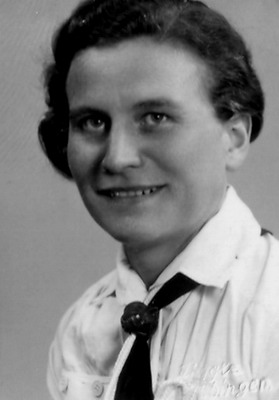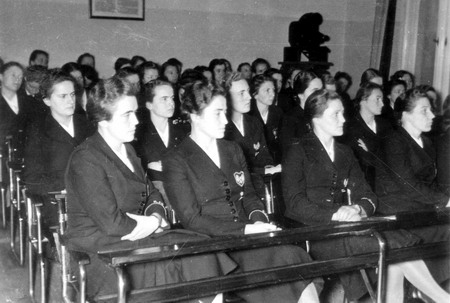→ Introduction
→ Leadership Selection
→ Leadership Training
→ Memo on Leadership Courses
 The leadership philosophy of the overall Hitler Youth, as well as of the League of German Girls, was “Youth led by Youth.”
The leadership philosophy of the overall Hitler Youth, as well as of the League of German Girls, was “Youth led by Youth.”
This held mostly true among the lowest ranking leadership staff, who were only a few years older than the girls they led (the youngest age at which a girl could hold leadership rank was 14), and were in turn helped and educated by their next-higher leaders who were only a few years older than them.
However, on the Gau and National level, leaders ranged in age from their mid-20s to their 40s. For example, the head of the Belief and Beauty Society, Clementine zu Castell, was 47 when she was appointed to that position, and Dr. Jutta Ruediger became the national speaker of the League in 1937, at age 27.
Among the ranks of the BDM, the average age of the Untergaufuehrerinnen was 23, and that of the Obergaufuehrerinnen was 27. The average length of peacetime service among full-time BDM leaders was 5 years, after which most either left to pursue careers (accounting for 20% of leaving leaders), or to start a family (80%).
The office responsible for appointment and training of leaders was the Personalamt der Reichsjugendfuehrung, or Personnel Office of the National Youth Leadership. Aside from selecting new leaders, the Office was also in charge of appointing duty positions, awarding rank, giving special awards, validating ancestry documentation, as well as overseeing the offices for School- and Higher Education Questions.
Leadership Selection
In all areas of the League of German Girls, new leaders were selected by those above them based on proficiency and character, as well as their education and attitudes. Some of the things that were looked for were an enterprising spirit, the ability to assert themselves, and personal character.
New leaders for the Jungmaedel could be chosen at any time during the year, while new leaders in the League of German Girls were chosen during the summer.
Girls could be chosen for the lowest rank, Jungmaedelschaftsfuehrerin, as early as age 13. Once chosen, the girl became a Fuehrerinnen-Anwaerterin, or leader candidate and received one year’s worth of training prior to being awarded rank.
The lower ranks in the BDM were held by unpaid volunteers, while higher ranks were paid, full-time positions. For the latter, girls were chosen from leadership schools and courses.
Additionally, an annual Fuehrerinnen-Bestandsaufnahme, or leadership inventory was taken on a regional level to select the best candidates among the existing staff of voluntary leaders for possible future full-time positions. Such appointments could be for unit, or area leadership, or heading specialty groups in the fields of sports, music, or cultural work. Depending on where and when they were needed, they could also be sent for further training.
In order to hold any full-time position within the League, girls had to prove their Aryan heritage, going back as far as the year 1800. However, if a girl was not of purely Aryan heritage, but had been exceptional in her service, she could still be accepted for the position if she was appointed by special mandate, which had to be personally effected by Adolf Hitler.
Leadership Training
Selection began on a local level, with the choice of candidates for the lowest rank in the Jungmaedel, Jungmaedelschaftsfuehrerin, and the lowest rank in the League, Maedelschaftsfuehrerin. Once chosen, a girl became Fuehrerinanwaerterin, or leader candidate, and had to attend a year’s worth of training prior to making rank.
In the city, this training was done by an Ausbildungseinheit, or training unit, which held sports afternoons and social evenings similar to regular BDM groups. In the country, a leader candidate generally served as deputy to her group leader during this time, and attended additional training in the form of weekend courses. Prior to graduating, participation in a leadership camp was required for all candidates.
Once a girl attained the rank of Jungmaedel- or Maedelschaftsfuehrerin, she had to participate in four to six training weekends during the wintertime, in which she received further instruction about her work; was shown examples of how to hold the sports of social evenings, and given a chance to discuss her tasks and service.
Leaders of Gruppen and Ringe received training at an Obergau Fuehrerinnenschule, or leaders academy, for three weeks every other years; while Untergau leaders attended the Reichsfuehrerinnenschule (national leadership school) in Potsdam.

Training consisted of sports (particularly gymnastics), philosophical education, and cultural work (particularly singing, crafts, theater, and folk art), as well as visits to the theater, concerts, exhibits, and poetry readings. Additionally, girls had to attend lectures and join work groups about the different aspects of their service. In the work groups, topics affecting leaders were discussed. For example, the mental and physical development of girls, and how to work together with parents.
Starting in 1936, Untergau leaders were required to attend one annual leadership conference at the Sports Academy in Weimar. During these annual conferences, leading personalities from the party, state and economy lectured on topics of political and other affairs, and BDM leaders from different regions had a chance to get to know each other and to network.
Obergau leaders had to attend three to four annual training conferences, held either by the National Speaker of the BDM, or the overall National Youth leader if the conference was for both male and female Hitler Youth leaders, during which lectures were given, and their work and current issues were discussed.
Aside from these main areas of leadership training, specialty schools also existed to educate suitable leaders, including the school for Philosophical Education, 3 BDM Sports Schools, 42 Obergau Leadership Schools, and one Administrative School.
Furthermore, there were courses in Musik, Crafts, Theater, and Medical Service, in which specially selected leaders were trained for work at the Obergau level.
Memo on Leadership Courses
The following text is a direct translation of a memo regarding leadership courses at the Academy for Youth Leadership, published by the National Youth Leadership Staff (RJF) on 2 September 1942.
Regulation on Leadership Courses at the Academy of Youth Leadership
2 September 1942
I. Prerequisites
a) Must have proven herself as a BDM leader (minimum of 1.5 years as leader of a JM- or Maedelgruppe, or leader of a JM– or Maedelring)
b) Must participate in a course at the Gebiet Leadership School
c) Must possess the BDM Proficiency Clasp
d) Must proove Aryan heritage back to 1800
e) Must possess certificate of medical fitness given by the Gebiets doctor
f) Must have finished education or vocational training
g) Must have fulfilled her Service Year or Labor Service obligation
h) Must be at least 19 years of age
II. Application and Selection
Bann leaders constantly notify the Personnel Offices of those girls who would like to become professional BDM leaders, and who are eligible for participation in the course at the Academy for Youth Leadership based on the Leadership Inventory. A special course is to be held for these Academy applicants by the leadership of the Gebiet. Out of those applicants, the best candidates’ information is to be forwarded to the Personnel Office of the Youth Leadership Staff (data sheet, photo, genealogy document, and service evaluation report from the Gebietsmaedelfuehrerin).
Academy candidates will then be required to participate in a six day long selection course of the Youth Leadership Staff.
Those academy candidates who have successfully completed a selection course will then be sent to a leadership course at the Academy for Youth Leadership. She must commit to a minimum of three years’ of service in her professional leadership role.
III. Assignment
Successful completion of the leadership course is to be followed by a three month assignment in the East. Afterwards, the leader will first be assigned for 6 months to the position of, for example, Hauptringfuehrerin, Ringfuehrerin z.b.V (for special assignment), etc. unless she has previously served in any of those positions for at least half a year.
Once these requirements have been fulfilled, she will be assigned to lead a Bann.
IV. Pay
Participation at the Academy is free of charge. During training, leader candidates will receive a monthly allowance.


